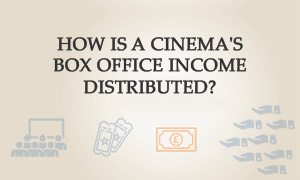How is a cinema's box office income distributed?

Today, I'm going to tackle a couple of related topics which seem to come up frequently in reader questions and comments - how is a cinema's box office income distributed, and how much of it ends up with the filmmakers?
On the face of it, the first question seems simple: how is box office ticket income divided? However, it has proved an ongoing controversy, with some filmmakers claiming that cinemas keep most of it and some cinema staff claiming that they hand almost all of it over to filmmakers. I have heard people on both sides wax lyrical about how they have the raw end of the deal.
In order to answer the question, I have been speaking to a number of people in both the distribution and exhibition sectors in the UK and I think I have uncovered what's really going on (and why both sides think they're right).
The second question of how much money ends up with the filmmakers presents a different challenge: namely that the economics of each film are unique. However, most films go through the same basic steps of recoupment, meaning we can trace the common route between box office income and profit for the filmmakers and investors.
It might help us to look at the second question first, i.e. to get an overall picture of how money flows back to the filmmakers before we tackle the nitty gritty of cinema box office income.
The recoupment waterfall
The way a film's income is collected and distributed is known as the Recoupment Waterfall. Income comes in from a variety of sources and the money is then handed back to the filmmakers via a number of third parties. Along the way, these third parties can recoup the money they spent up front promoting the film and also charge a pre-agreed fee for their work. What's left after a party has repaid costs and kept their fees will be passed down the chain to the next party.
Each film has its own unique waterfall but the majority will follow the following pattern (this chart uses a fictional film as an example):

There are a bunch of notes, definitions, and explanations which go with today's graphics and examples. I have moved them to the end of this article for readability, so please have a look before emailing me in a state of confusion or outrage.
The final part of the waterfall is listed here as 'Producers' Net Profits' and is when the remaining money reaches the bank account of the production company (or that of their appointed collection agent) and needs to be divided. Typically, the investors are repaid in full, and then the money is split 50:50 between the Investors' Pool (i.e. profit for the investors) and the Producers' Pool (i.e. the money shared with certain members of cast and crew who were assigned a share of profits). In many cases, investment deals can be slightly more complicated, such as:
Each investor could have different terms, with some negotiating to be paid before others, or to get a fixed return rather than a slice of all profits in perpetuity.
Major stars can demand a percentage of the gross income, rather than the net income in the Producers' Pool. This explains why a star can earn millions on a "profit participation" deal, even when the film is not technically in profit.
Some of the film's budget may have been provided by tax rebates, meaning that a "$30 million film" may need far less than $30 million to ensure all investors are fully repaid.
Bring on the numbers...
Let's apply some numbers to this waterfall to see how the money flows (or maybe trickles is a better adjective, as in "Trickle Down Recoupment"). The actual fees will vary between films, so the ones I've used are the average fees of 1,235 film professionals I interviewed in 2014.
Let's create a fictional film with a production budget of $30 million which grossed $75 million at cinemas around the world. The income figures below are the amount after deductions, such as sales taxes and money kept at the point of sale (i.e. the amount Odeon, HMV or Apple keep from each transaction).

In the example above, the investors had their initial money repaid ($30 million) and then received a further $1.8 million, representing a return of 106%. That's very positive from the point of view of the film industry (i.e. there is actually profit!) but probably pretty poor from the point of view of traditional investors, especially considering the risk they took and the time before they were repaid.
In addition, the Producers' Pool received the same amount, meaning that if an actor was promised 5% of the producers' share of profits, then they would have received just under $90,000, on top of whatever up-front fee they were paid.
The final recoupment waterfall for a real film will rarely be as neat as my example. Some complicating factors could include:
Each country the film is distributed in could have different tax rates and rules around distributing content.
Each distributor may negotiate unique terms, including different P&A requirements and fee arrangements.
Some distributors could pay a single fixed amount rather than a share of income (common practice in China, for example).
A sales agent will often agree different fees for certain territories, such as a lower fee for the film's home country, as that is regarded as an easier sale.
Interest can sometimes be factored into money spent up front.
Currency fluctuations will affect income.
What share of box office income do cinemas keep?

The keen-eyed among you will have noticed in the previous graphic that although our film grossed $75 million, we only received $34 million. This is because before we get our hands on box office income, there are two big deductions.
Firstly there's tax. Sales tax varies wildly between countries, so I used a figure of 10% for this example (in the UK it's currently 20%). Some countries also apply other taxes, e.g. India charges an Entertainment Tax of between 2% and 50%, depending on the type and scale of film.
The other big deduction is the amount the cinema (a.k.a. exhibitor or movie theatre) keeps. This is a rather contentious figure as different corners of the industry disagree vehemently as to what split is normal. When I interviewed over 1,000 film professionals in 2014, the average figure according to distributors was 49% but exhibitors reported it as 43%.
When I interviewed UK cinema staff in 2015, over a third claimed that high ticket prices were due to cinemas handing over most of the money. A common refrain was that sweets were expensive because cinemas "only get 10% of ticket prices so they have to make some money somewhere".
In order to get to the bottom of this figure, I have spoken to a number of people 'in the know' in both distribution and exhibition in the UK. Some were quite senior and I am confident that the figure I built up is an accurate reflection of the UK market as it stands today. Here are the salient points:

The vast majority of mainstream movies released in the UK work on an income split, whereby the exhibitors and distributors split the ticket income after VAT (UK sales tax) is removed. Other models are sometimes used, including a 'House Nut' where the first £x of income is kept by the exhibitor after which income is split, or 'Four Walling' where distributor pays a fixed fee for the screen and keep all ticket sale income (minus handling fees).
There isn't one universal figure. The split between exhibitors and distributors can be different for each film and is a point of negotiation when discussing the deal.
The split changes over time, in favour of the exhibitor. Distributors can usually negotiate a better deal in the opening week or two and so the longer a movie plays, the more the exhibitor will keep from each ticket sold. For example, a distributor may receive 55% of ticket sales in weeks one and two, 50% in week three, 45% in week four, right down to a base of 30% in the final weeks.
Only the biggest movies commonly claim more than 50% of income. When they do, it is almost always from a major distributor and only in the first week or two of the film's run. As one expert put it "a 55% split in favour of the distributor is generally regarded as a great deal and some recent major releases have achieved that". I understand that recently a certain expensive sci-fi movie from a major studio managed to secure 65% of income in its opening week but this is regarded as exceptional.
Distributors of independent films typically receive between 28% and 35% of income. This means that for some 'specialist' titles (art house films, small foreign language films, documentaries, etc), the exhibitors are keeping up to 72% of the ticket sales. That said, most of these titles have a minimum guarantee attached, to prevent the distributor from getting pennies. A typical deal is "35% vs an MG of £100", meaning that the exhibitor must pay the distributor either 35% of the box office or £100, whichever is the greater.
The UK has among the highest exhibitor splits in the world. This is partly due to the relatively high cost of media advertising in the UK and also due to historic deals between British cinemas and distributors.
The power in the sector is shifting - in both directions. As more movies than ever before are being pushed onto the UK theatrical market, exhibitors have increasing power to demand better terms from all but the biggest movies. However, at the top-end, the tentpole studio movies are bigger than ever before (budgets and marketing spend), meaning distributors releasing major mass-appeal titles are able to secure much better than average terms in opening weekends’. The smaller films are being squeezed by exhibitors and the big films are squeezing the exhibitors.
Where did the myth of cinemas only keeping 10% of box office income come from?

I asked around and it seems that it's got its origins in a real event, but is a case of misunderstanding. In the words of someone senior in UK distribution:
The “90%’ figure quoted probably relates to a rare deal a while ago with a major cinema chain, which applied it to the first tranche of income, in the form of a ‘house nut’. It’s extremely unlikely that a 90% deal has ever been agreed for all the box office income for a movie".
On the other hand, someone from another part of the distribution chain said:
Personally I think you’re being a bit too overly diplomatic with the reason for the 10% thing! Exhibitors in general have a bad view of distributors taking all the cash... and also because they use it to justify their concession charges to customers
As we saw with the differing opinions on average fees from my survey, it's unlikely that everyone from the industry will be able to agree on one interpretation of 'common practice'. However, I'd like to think I was able to get some clarity on this issue and bust a few myths.
I'll leave you with an old industry joke which Geoff Greaves, owner and operator of the Merlin Cinemas chain, told when picking up his Exhibition Achievement Award at last October's Screen Awards. He described turning up to a coffee meeting, finding no cream to add and declaring "The distributors must have got there first".
Further reading on box office income
If you're interested in learning more about the topics mentioned above, then you may enjoy these other articles:
Notes

Below are some definitions and notes to go along with the recoupment waterfall graphic:
The income boxes are not to scale. i.e. Non-theatrical income is a fraction of Theatrical income but is shown the same size on the graphic for readability.
'Other' income includes merchandise, movie tie-ins, novelisations, soundtracks, etc.
P&A stands for Prints and Advertising and these are the costs the distributor pays to bring the movie to cinemas and promote it to the general public.
The example is an independent film. Films made by studios are typically distributed by the studio's own distribution operations around the world. In theory this could remove the third party fees charged by sales agents and distributors but in practice the studios charge themselves similar fees. This is partly because the studio distribution companies are legally separate entities (to comply with anti-trust laws) but also because it reduces the official profit, thereby reducing the amount they have to pay out to people with a profit share. In smaller markets, studios may use third parties where they've judged the costs of running their own permanent distribution operation is too high.
The example of the working waterfall is fictional. Grossing $75 million worldwide on a $30 million budget is a middling box office tally. Other movies of the same budget include Steve Jobs (which grossed $35m worldwide), Entourage ($49m), The Next Three Days ($67m), Sicario ($78m), Deliver Us From Evil ($88m), Kick-Ass ($98m), and La La Land ($272m so far).
Epilogue
I am very grateful to the people who helped me with this article. I spoke to a number of industry professionals, some very senior, in order to get to the bottom of how this part of the industry functions. Most were hesitant about speaking out until I agreed not to print their names. It seems that there is a real taboo in the distribution sector about going on the record with things like the terms of deals. Some of this may be down to non-disclosure agreements and UK competition law (which places limits on what commercial information companies can share with rivals) but most seemed to stem from a more general sense of secrecy.
Interestingly, almost everyone I speak to in the industry decries the culture of secrecy and opaqueness but few are willing to be the first to put their head above the parapet. And I understand that - being one of the few people to share private or commercial information can't be fun. Hopefully, over time we can change this so we can all learn from each other and work together to help the industry function better.



"This is partly because the studio distribution companies are legally separate entities but also because it reduces the official profit, thereby reducing the amount they have to pay out to people with a profit share."
What? How? Doesn't that count as accounting fraud?
Hi Stephen, thanks for the insights you shared. I’m just wondering how things in the industry may have changed since you wrote this article? It seems that the Production company always comes off worse as far as the profits go. Would for instance, self-distribution really work to bring in profits above the levels highlighted in the article?